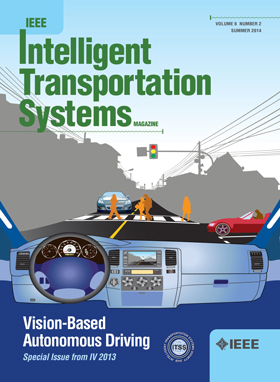Sharing Control Knowledge Among Heterogeneous Intersections: A Distributed Arterial Traffic Signal Coordination Method Using Multi-Agent Reinforcement Learning
IF 7.9
1区 工程技术
Q1 ENGINEERING, CIVIL
IEEE Transactions on Intelligent Transportation Systems
Pub Date : 2025-01-06
DOI:10.1109/TITS.2024.3521514
引用次数: 0
Abstract
Treating each intersection as basic agent, multi-agent reinforcement learning (MARL) methods have emerged as the predominant approach for distributed adaptive traffic signal control (ATSC) in multi-intersection scenarios, such as arterial coordination. MARL-based ATSC currently faces two challenges: disturbances from the control policies of other intersections may impair the learning and control stability of the agents; and the heterogeneous features across intersections may complicate coordination efforts. To address these challenges, this study proposes a novel MARL method for distributed ATSC in arterials, termed the Distributed Controller for Heterogeneous Intersections (DCHI). The DCHI method introduces a Neighborhood Experience Sharing (NES) framework, wherein each agent utilizes both local data and shared experiences from adjacent intersections to improve its control policy. Within this framework, the neural networks of each agent are partitioned into two parts following the Knowledge Homogenizing Encapsulation (KHE) mechanism. The first part manages heterogeneous intersection features and transforms the control experiences, while the second part optimizes homogeneous control logic. Experimental results demonstrate that the proposed DCHI achieves efficiency improvements in average travel time of over 30% compared to traditional methods and yields similar performance to the centralized sharing method. Furthermore, vehicle trajectories reveal that DCHI can adaptively establish green wave bands in a distributed manner. Given its superior control performance, accommodation of heterogeneous intersections, and low reliance on information networks, DCHI could significantly advance the application of MARL-based ATSC methods in practice.求助全文
约1分钟内获得全文
求助全文
来源期刊

IEEE Transactions on Intelligent Transportation Systems
工程技术-工程:电子与电气
CiteScore
14.80
自引率
12.90%
发文量
1872
审稿时长
7.5 months
期刊介绍:
The theoretical, experimental and operational aspects of electrical and electronics engineering and information technologies as applied to Intelligent Transportation Systems (ITS). Intelligent Transportation Systems are defined as those systems utilizing synergistic technologies and systems engineering concepts to develop and improve transportation systems of all kinds. The scope of this interdisciplinary activity includes the promotion, consolidation and coordination of ITS technical activities among IEEE entities, and providing a focus for cooperative activities, both internally and externally.
 求助内容:
求助内容: 应助结果提醒方式:
应助结果提醒方式:


